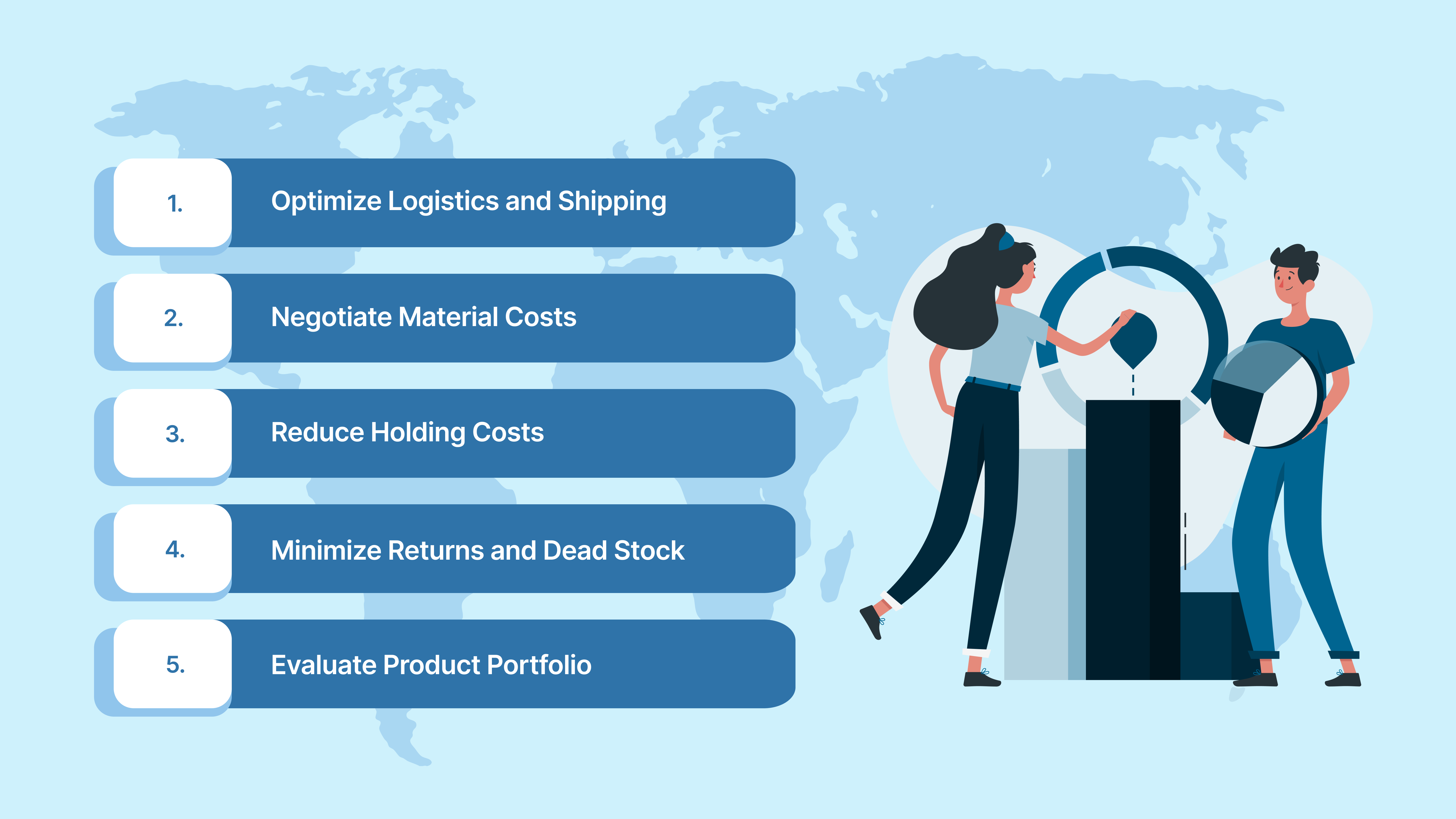In business and finance, understanding costs is crucial for making informed decisions and ensuring profitability. One of the key metrics in cost management is unit cost, which refers to the cost of producing a single unit of a product or service.
For e-commerce businesses in the Philippines, accurately calculating unit cost is essential for setting competitive prices and maintaining healthy profit margins. By understanding unit costs, e-commerce businesses can smooth operations, reduce unnecessary expenses, and make smarter decisions about pricing, marketing, and inventory management.
This blog will guide you through the unit cost formula, explore its applications, and explain how it can help optimize your business operations.
Unit cost refers to the total cost incurred to produce a single unit of a product or service. It includes all direct costs, such as materials, labor, and manufacturing overhead, divided by the total number of units produced. For example, if it costs PHP 500,000 to produce 1,000 units of a product, the unit cost would be PHP 500 per unit.

In highly competitive markets, efficiently managing unit costs can make the difference between staying profitable and falling behind.
Next, let’s look at the mechanics of how you can calculate your unit cost effectively.
Understanding the cost of producing one unit is crucial for informed pricing decisions and effective cost management strategies. Let’s break down the formula and see how it works:
Unit Cost = Total Cost / Number of Units Produced
Understanding the components of this formula is crucial, as it allows you to determine the true cost of producing each item. Let’s break it down step-by-step:
Let’s consider a simple example to make it clearer:
Total Cost = Fixed Costs + Variable Costs
Total Cost = PHP 100,000 + PHP 50,000 = PHP 150,000
Now, let’s calculate the unit cost:
Unit Cost = Total Cost / Number of Units Produced
Unit Cost = PHP 150,000 / 1,000 units = PHP 150 per unit
This calculation shows you that each unit costs PHP 150 to produce, and knowing this helps you set your pricing strategy and assess profitability.
To effectively apply the unit cost formula, it’s important to see how it influences various areas of your business. Let’s explore some of the key applications of the unit cost formula.
The unit cost formula is crucial in various aspects of your business. Understanding and applying it effectively can drive profitability and operational efficiency. Here’s how the unit cost formula comes into play in key business areas:
Unit cost helps you determine competitive yet profitable pricing. By knowing your unit cost, you can ensure your prices cover costs and maintain healthy profit margins, preventing potential losses.
Unit cost calculations allow you to spot inefficiencies in your production process. By identifying areas where you can reduce costs, whether in labor, materials, or overhead, you can make adjustments to optimize operations and lower overall costs.
Understanding unit costs helps assess the profitability of individual products or services. You can identify which items generate the highest profits and focus your resources on promoting or improving those.
Having accurate unit cost data allows you to create more accurate and realistic budgets. By knowing how much it costs to produce each item, you can forecast better, set goals, and allocate resources efficiently.
By tracking unit costs, you can optimize your inventory management practices. Knowing the cost of each item helps make better purchasing decisions, prevent overstocking, and reduce inventory holding costs.
These applications illustrate the impact that understanding unit costs can have on your business decisions. To effectively optimize your unit cost and improve overall efficiency, it’s crucial to understand the factors that influence it.
Various elements, ranging from fixed and variable costs to economies of scale, play a significant role in determining the cost of producing each unit. Here’s a breakdown of the key factors:
| Factor | Description | Impact on Unit Cost |
| Fixed Costs | Costs that remain constant regardless of the production level, such as rent, salaries, and equipment. | Fixed costs are spread over more units as production increases, reducing the per-unit cost. |
| Variable Costs | Costs that fluctuate depending on production volume, such as raw materials, labor, and utilities. | As production volume increases, variable costs increase proportionally, affecting the unit cost. |
| Economies of Scale | Cost advantages gained as production scales up, leading to more efficient use of resources. | Larger production volumes often lower unit costs by spreading fixed costs over more units and reducing variable costs. |
Also Read: Comprehensive Guide to Logistics Planning Strategies

Reducing unit cost is crucial for e-commerce businesses to stay competitive while maintaining profitability. By cutting production and operational costs, you can improve your profit margins without compromising product quality. Here are a few strategies that can help you reduce unit costs:
One of the biggest contributors to high unit costs is inefficient logistics. You can lower logistics costs by focusing on key areas such as:
Efficient logistics lowers the cost per unit and ensures faster delivery, improving customer satisfaction and loyalty.
Material costs are a significant portion of the unit cost for most e-commerce businesses. Here’s how you can reduce these costs:
Holding costs include all expenses related to storing unsold inventory. To minimize these costs:
By reducing holding costs, you’ll be able to lower your overall unit costs and free up capital for other business needs.
Returns and unsold inventory can significantly inflate your unit costs. To tackle this:
Managing returns and stock more effectively will prevent unnecessary costs and help reduce the cost per unit.
Not all products are created equal when it comes to profitability. If you have items that aren’t performing well, it’s time to evaluate whether they’re worth keeping. Consider:
Removing low-performing items from your catalog will reduce overhead costs and allow you to focus on what works, lowering your overall cost per unit. Next, let’s look at some of the hurdles you might face when calculating the unit cost.
Accurately calculating unit costs can be a daunting task for many businesses, as it involves navigating through various complexities and uncertainties. Let’s explore the key challenges you may face in this process.
Many businesses have complex cost structures, especially those with a mix of direct and indirect costs. Allocating indirect costs, such as administrative expenses or overheads, can be tricky and may result in inaccurate unit cost calculations. Businesses need a clear method for attributing costs to the correct products or services.
In industries where raw material prices or labor wages fluctuate, maintaining consistent unit costs can be challenging. For example, in the manufacturing industry, sudden increases in material costs can significantly impact the unit cost. These fluctuations must be carefully monitored and factored into the calculations to avoid underpricing or overpricing products.
Reliable unit cost calculations rely on accurate and complete data. Businesses need to track costs meticulously across various departments and production processes. Any inaccuracies in the data can distort the unit cost, leading to poor pricing decisions, financial losses, or missed opportunities for cost reduction.
Inspire Solutions Asia understands the complexities of managing unit costs for businesses. With our efficient logistics, inventory management, and data-driven solutions, we help businesses optimize their operations and reduce costs. Get in touch today to discover how our solutions can manage your supply chain and make your business more profitable.
Accurate unit cost calculations are essential for businesses to optimize operations, control costs, and improve profitability. Here’s how you can enhance the accuracy of your unit cost calculation process:
Improving unit cost accuracy helps in better decision-making and strengthens your financial control and efficiency. By investing in the right tools, regularly reviewing cost data, and analyzing variances, you can make your unit cost calculations more reliable.
Also Read: How to Calculate and Use the Reorder Point Formula
At Inspire Solutions Asia, we provide customized services to help you efficiently manage unit cost calculations and smooth your operations. By integrating technology, offering strategic support, and ensuring accurate data management, we can help you optimize your cost structure. Here’s how we assist you in improving unit cost calculations:
With Inspire Solutions Asia’s expertise, you can ensure that your unit cost calculations are precise, that your cost structure is optimized, and that your business operates more efficiently.Get a Quote today to learn how we can help improve your unit cost management and support the growth of your business.
Accurately calculating unit costs is essential for any business looking to maintain profitability and make informed decisions. By understanding the factors that influence unit cost and implementing strategies to optimize calculations, businesses can ensure more efficient operations, better pricing strategies, and improved financial performance. Whether dealing with fluctuating costs or complex cost structures, taking a proactive approach to unit cost management can give your business a competitive edge.
If you’re ready to optimize your cost management and improve your operations, schedule a meeting with Inspire Solutions Asia today. Let us guide you through the process and help manage your business growth.